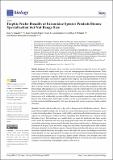Por favor, use este identificador para citar o enlazar a este item:
http://hdl.handle.net/10261/270996COMPARTIR / EXPORTAR:
 SHARE SHARE
 CORE
BASE CORE
BASE
|
|
| Visualizar otros formatos: MARC | Dublin Core | RDF | ORE | MODS | METS | DIDL | DATACITE | |

| Título: | Trophic Niche Breadth of Falconidae Species Predicts Biomic Specialisation but Not Range Size |
Autor: | Fargallo, Juan A. CSIC ORCID ; Navarro-López, Juan CSIC; Cantalapiedra, Juan L. CSIC ORCID ; Pelegrín-Ramírez, Jonathan S.; Hernández Fernández, Manuel | Palabras clave: | Biome Ecological specialisation Diet richness Diversity Falconiformes Generalist Phylo genetic signal Specialist Species distribution |
Fecha de publicación: | 29-mar-2022 | Editor: | Multidisciplinary Digital Publishing Institute | Citación: | Biology 11(4): 522 (2022) | Resumen: | Trophic niche breadth plays a key role in biogeographic distribution patterns. Theory posits that generalist strategies are favoured in a more heterogeneous set of environments across a spatio-temporal gradient of resources predictability, conferring individuals and species a greater capacity for colonising new habitats and thus expanding their distribution area. Using the family Falconidae (Aves, Falconiformes) as a model study, we tested the prediction that those species with a wider diet spectrum will have larger geographic range sizes and inhabit more biomes. We assessed the relationships between trophic breadth (diet richness and diversity) at different taxonomic resolutions of the prey (class and order), range size and biomic specialisation index (BSI; number of biomes inhabited) for the different species. Despite different diet breadth indexes and taxonomic resolutions defined differently the trophic niche of the clade and species, our findings revealed that trophic breadth was not a good predictor for range size but was for total environmental heterogeneity, with more diet-generalist species occupying a higher number of biomes. Diet breadth at the order taxonomic level showed a higher capacity of predicting BSI than at class level, and can be an important ecological trait explaining biogeographic patterns of the species. | URI: | http://hdl.handle.net/10261/270996 | DOI: | 10.3390/bilogy11040522 | ISSN: | 2079-7737 |
| Aparece en las colecciones: | (MNCN) Artículos |
Ficheros en este ítem:
| Fichero | Descripción | Tamaño | Formato | |
|---|---|---|---|---|
| Fagallo_JuanA_Trophic.pdf | Artículo principal | 1,34 MB | Adobe PDF |  Visualizar/Abrir |
CORE Recommender
Page view(s)
35
checked on 15-may-2024
Download(s)
35
checked on 15-may-2024
Google ScholarTM
Check
Altmetric
Altmetric
NOTA: Los ítems de Digital.CSIC están protegidos por copyright, con todos los derechos reservados, a menos que se indique lo contrario.
